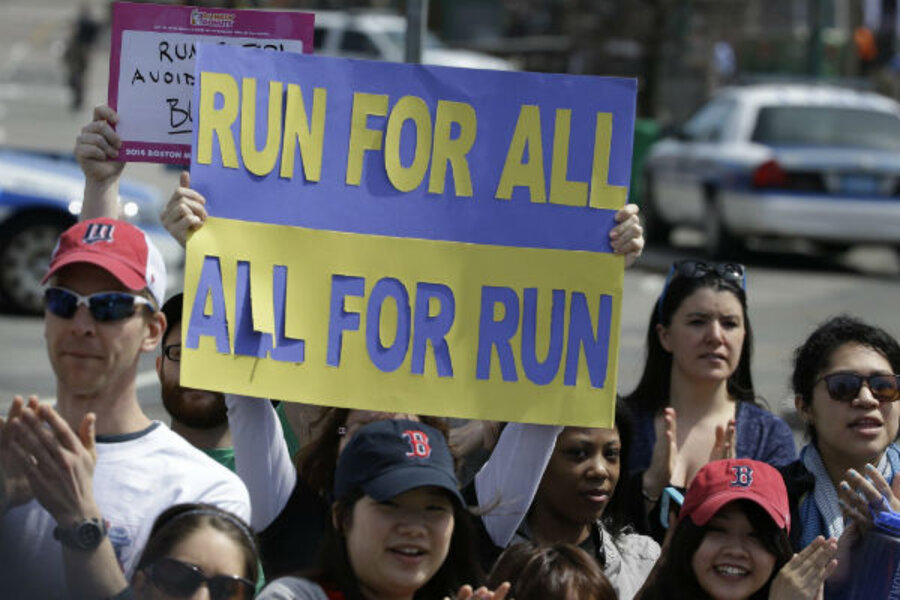On historic day, Boston keeps calm and marathons on
Loading...
| Boston
Outside Fenway Park, a young woman wrestles with an onion-smothered sausage, a Boston rite of spring on Patriot's Day weekend. Her T-shirt reads, “Keep calm and marathon on.”
Just down the street, some 36,000 runners are in fact “marathoning” on, in the first Boston Marathon since two explosions erupted at the finish line last April. Refusing to be scared away from the city’s beloved marathon, thousands of people turned out to line the marathon route and cheer the runners on.
There were some definite differences along the course this year. Spectators had to pass through police checkpoints to reach the course, and those carrying bags had to submit to search. Police in full uniform and fluorescent yellow jackets, khaki-clad cadets from Boston Police Academy, and plainclothes officers kept a close eye on the crowd.
For the most part, spectators welcomed the police presence.
Amanda Gordon was near the finish line last year when the bombs went off and says that she greatly appreciates the additional security.
“Right now I feel like Boston’s the safest city in America,” Ms. Gordon says from a perch atop a railing along Commonwealth Avenue in Boston’s Kenmore Square.
Despite the intense police presence, the general atmosphere was celebratory but calm. People strolled down the sidewalk soaking in the joy. Revelers, sometimes six people deep, lined the curb and cheered on the steady stream of runners. In front of the Hotel Commonwealth, two young girls lay sprawled on the red carpet leading into the hotel lobby, drawing on the back of signs. Shopkeepers abandoned their registers to sit on stoops and relish the day.
By noon, there were so many people lining the course, it was difficult to actually see more than sweaty heads bobbing by.
One spectator, Edward McCarver of Wallingford, Conn., ran 14 Boston Marathons between 1984 and 2004, and he’s cheered other runners on in every marathon since.
“There’s just something about the Boston Marathon,” Mr. McCarver says.
Last year, he and his son Drew, who lives in South Boston, were around the corner from the finish line when the bombs exploded. But that didn’t stop them from coming back this year.
“What happened last year just enhanced my love for this city,” the father says.
This year, the father and son watched from the sidewalk in Kenmore Square, less than a mile from the finish line.
“The energy here today is very strong and palpable,” the younger Mr. McCarver says. “People really have embodied the motto of ‘Boston Strong.’ It’s all around us.”
One runner, Brad Holzwart a government contractor from Fairfax, Va., said that he could feel that strength emanating from the crowd throughout the race.
When he made the final turn onto Boylston Street toward the finish line, “All of the pain and exhaustion just melted away," he says, still wrapped in a Boston Athletic Association foil warming poncho after reuniting with his family in the lobby of the Sheraton Hotel, where he is staying. "There are all of these people screaming for you who don’t even know you and their cheers echo off the buildings. I definitely felt chills and shed a few tears at that moment.”
From the moment he stepped of the plane, he felt that the celebratory atmosphere had been restored, he says. Throughout the weekend, strangers approached him to wish him luck.
“The city in general is such an electrifying place on marathon weekend” – but this year the crowd support was even greater, he says.
Mr. Holzwart ran the marathon last year and had already finished the race and was back at his hotel room three-quarters of a mile away when the bombs went off. At first he had hoped that the noise was a some kind of celebratory cannon, but quickly learned of the devastation at the finish line.
“It was a day of celebration, but when that happened, the whole complexion of the day completely changed,” he says. “I felt guilty for being happy about what I had accomplished.”
There was no question that he would return to Boston this Patriot’s Day to run in honor of the people who died last year and the city.
“In my mind the Boston Marathon is the best marathon in the world,” he says.








